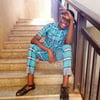Why Should Developers Care About Art? Why Should Artists Learn to Code?
This is an article about art. What place does art have on a platform “[w]here developers share ideas and help each other grow”? (https://dev.to/about) Art and digital technology have been in conversation for a few decades now, but in my experience, the vast majority of working artists are reticent to adopt all but the most user-friendly technologies and digital platforms. Many artists choose instead to work with older technologies that, while established, have no less steep of a learning curve than learning a programming language.
Similarly to learning a first programming language, an artist learning a new-to-them technique will quickly find that learning an isolated skill is not enough. In concrete terms, if a new developer wants to learn JavaScript, they will be well-served to also learn HTML, CSS, a bit of Jquery, and they might as well throw in a few frameworks while they’re at it. All of these skills together allow the developer to put their work out into the world in a form that can be seen and used. If a new photographer wants to learn how to shoot still film, they must learn about the subtle and not-so-subtle optical distortions created by various lenses and the science of how the human eye perceives spatial orientation if they want their work to feel immersive. They must also dip their toes into the vast ocean of knowledge that is film development, since competent film development is almost extinct as a service. Without knowledge of complementary technologies, knowing how to take a photograph is useless since the artist cannot put that art out into the world.
The history of art has fundamentally been a history of technological innovation, from the invention of lost-wax casting by Ancient Greeks, the use of camera obscuras and invention of oil paint by Northern Renaissance artists, to Anish Kapoor’s hotly contested exclusive right to use the recently invented Vantablack coating. However, many artists are unduly intimidated by digital technology, and digital art--though it is a vast constellation of technologies-- is often seen as immature in style and theme or impersonal in execution. Despite the largess of new techniques and mediums that current technology can add to fine art exhibition and creation, digital artworks are too often dismissed as novelties.
If you thought that digital art isn’t “serious” art, or that contemporary technology-based artworks are impersonal, or cheesy, I would like to present you with the following list of digitally-created artworks that I think represent the most fruitful conversations between the visual arts and computer programming to date. Some of these projects are executed on a huge scale with a corresponding budget, while others are much smaller in both budget and audience. All are innovative in the application of digital technology to visual arts experiences.
L’orangerie Virtual Visit
by Google Art Project, started mid-2009
(https://www.musee-orangerie.fr/en/article/water-lilies-virtual-visit)
The Musee de L’Oranagerie’s Virtual Visit may not be the flashiest project on this list, but it solves an age-old problem in art exhibition: How do you get the world to your art collection when your collection cannot travel due to unwieldy size or extreme fragility? The Musee de L’Orangerie is renowned for its collection of eight curved waterlilly paintings by Claude Monet, which it houses in two custom-designed ovoid rooms. These paintings are all two meters in height and range from 6 to 17 meters in width. These goliath paintings and their unique exhibition space can be visited from anywhere in the world through the museum’s website. The user experience is similar to that of Google Maps’ streetview feature, mainly since it was created by Google. The Virtual Visit allows the viewer to have the feeling of walking around the gallery and examining the paintings from every possible angle.
ABZU
developed by Giant Squid, published by 505 Games
Initial release August 2016
(https://abzugame.com/)
ABZU is a freeform underwater exploration video game. While there are some goal-like elements of game play, the primary experience of ABZU is a mediative wander through ocean environments where the player encounters various sea life and some sunken structures. Since this game does not require any video game play skill, playing ABZU is much like the meditative experience of wandering through a museum and allowing your eyes to take in the art around without worrying too much about analysis.
L’Atelier des Lumieres by Culturespaces
Opened April 2018
(https://www.atelier-lumieres.com/)
This workshop of lights houses an immersive experience in a disused warehouse in Paris where every inch of the walls and floor are covered in projection-mapped artworks. Projection mapping is simply the use of 3-D design software to display virtual art in a 3-dimensional space. The effect is such that the walls and floor appear to have been covered in incredibly detailed, glowing paintings. The initial opening of L’Atelier focused mainly on riffs on works by the well-known Symbolist and Art Nouveau artist Gustav Klimt(1862-1918). While some of Klimt’s works, such as The Kiss, are popular as reproductions and prints on all kinds of consumer goods, L’Atelier lends a monumental feel to his art. Projection mapping is a growing sector of digital art since it is relatively easy for artists already versed in digital tools such as Photoshop or Blendr to pick up. L’Atelier makes Klimt’s artworks feel new again by re-imagining them in a new medium. This combination of new and old makes it easy for audiences to accept this use of projection mapping as an acceptable medium for fine art.
Sandbox Ocean 2.0 by Sanghun Heo and Wansup Choi as seen on DevArt.com
2014
https://devart.withgoogle.com/#/project/17662954?q=javascript
Sandbox Ocean 2.0 is an extension of a project began by developers Heo and Choi in 2011 that compresses projection mapping down to a small scale, and makes it even more interactive than walk-through experiences like L’Atelier des Lumieres. Essentially, an ocean scene with water, sand, and sea creatures is projected onto a plastic bin full of sand. As the user plays with the sand, the projection reacts in real time to hills and valleys shifting, appropriately projecting islands onto the highest points, and water onto lower points. Deep water dwelling creatures appear only in places where the sand levels are the lowest and shallow water dwelling creatures, such as crabs and starfish, appear in areas close to “islands”. The effect, like ABZU, is meditative and complex. Luckily, the developer-artists provided a detailed explanation of how they created Sandbox Ocean and listed their techstack on DevArt.com.
DevArt is a subsidiary of Google. It is a platform for small digital art creators to show off the visual and technical aspects of their work, and to find inspiration from others who work in similar mediums. I highly recommend taking some time to explore more of the projects on this platform.
There are so many more amazing, innovative tech-based art projects that I could write about here, but I hope the four examples I gave make it clear how diverse applications of coding to fine art are in 2019. If you’re an artist, take advantage of the customization that original code can add to your work, and don’t let yourself be limited by the digital software that is currently available(or that you can currently afford). If you’re a developer, consider using your current skill set to create some original art. HTML5’s Canvas feature or basic projection mapping is a great place to start.






Top comments (0)